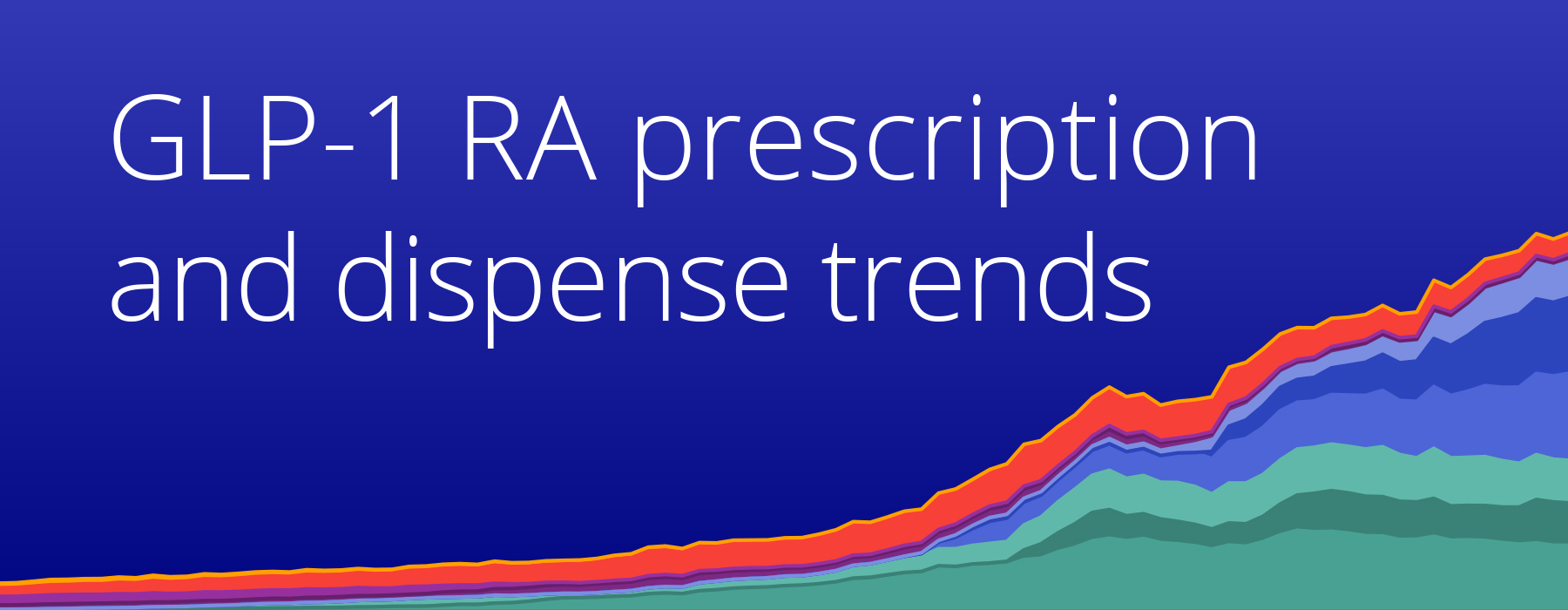- Overall GLP-1 prescribing rates (GLP-1 RA prescriptions per total prescriptions) in September 2025 remained stable relative to June 2025 (+4.6%). As of September 2025, GLP-1 prescriptions account for 6.5 out of every 100 prescriptions in the US.
- Tirzepatide continues to be the most prescribed anti-diabetic (ADM) and anti-obesity (AOM) medication (sold as Mounjaro and Zepbound, respectively).
- For patients with first-time anti-obesity medication prescriptions in March 2025, only 46.8% had evidence of a prescription fill within 60 days, compared to 72.2% of patients receiving anti-diabetic medication prescriptions; this indicates there may be ongoing access issues related to cost or insurance.
Limited recent data exist on prescribing patterns and patient characteristics for GLP-1 RA medications, whether used as anti-diabetic medication (ADM) for patients with type 2 diabetes (T2D) and/or used as an anti-obesity medication (AOM) for patients with overweight or obesity. Interest in these medications has recently accelerated, largely for their weight-loss effects, although access to and use of GLP-1 RA medications may be impacted by high cost, limited insurance coverage for patients without T2D and medication shortages.
To offer insight into the latest trends about these medications, Truveta Research has created the GLP-1 RA monitoring report, which will be updated periodically with fresh, timely data. Truveta Data provides the most representative, complete, and timely patient journey data, including full patient medical records, notes, and images, for more than 120 million patients across the US. Truveta Data is also linked with closed claims for more than 200 million patients. Because Truveta Data is updated daily, we can show the latest trends in these medications.
This blog provides a snapshot of the key findings in the most recent report; including prescribing and dispensing medication (indicates whether the patient picked up the medication) trends. For the full analysis—inclusive of demographics, comorbidities, and social drivers of health data for the population, methodology, additional findings, limitations, and citations—you can view the complete report on MedRxiv or directly within Truveta Studio.
Key findings: Prescribing trends
Using a subset of Truveta Data, Truveta Research identified people who were prescribed a GLP-1 RA between January 01, 2018 and September 30, 2025. We describe prescribing volumes and patient characteristics over time, by medication, and by FDA-labeled use (e.g., ADM, AOM, or unknown).
Overall prescribing trends
The study found that 2,454,615 patients were prescribed a GLP-1 RA between January 2018 and September 2025, with 12,203,009 total prescriptions during this period.
As of September 2025, GLP-1 prescriptions account for 6.5 out of every 100 prescriptions in the US.
Overall prescribing rates (GLP-1 RA prescriptions per total prescriptions) in September 2025 remained stable relative to June 2025 (+4.6%).
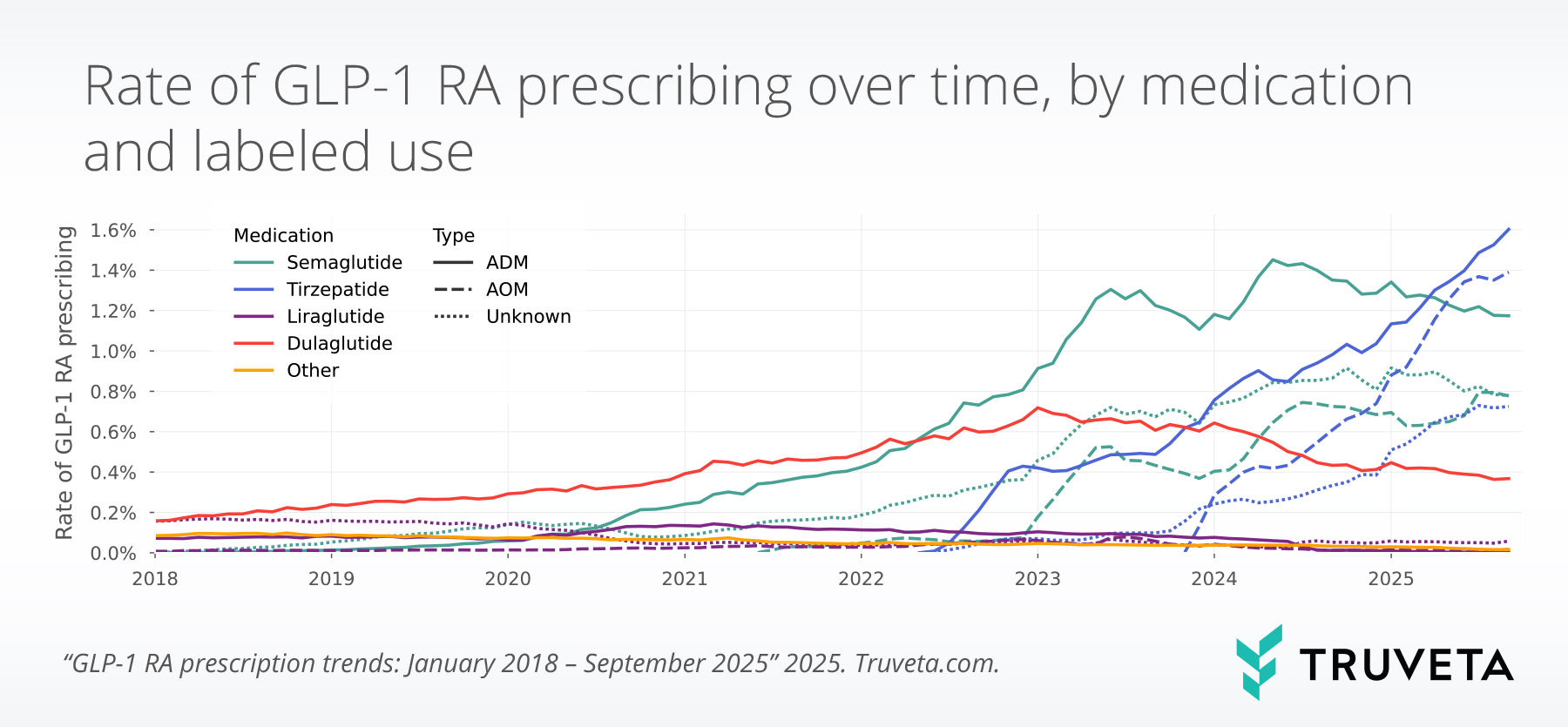
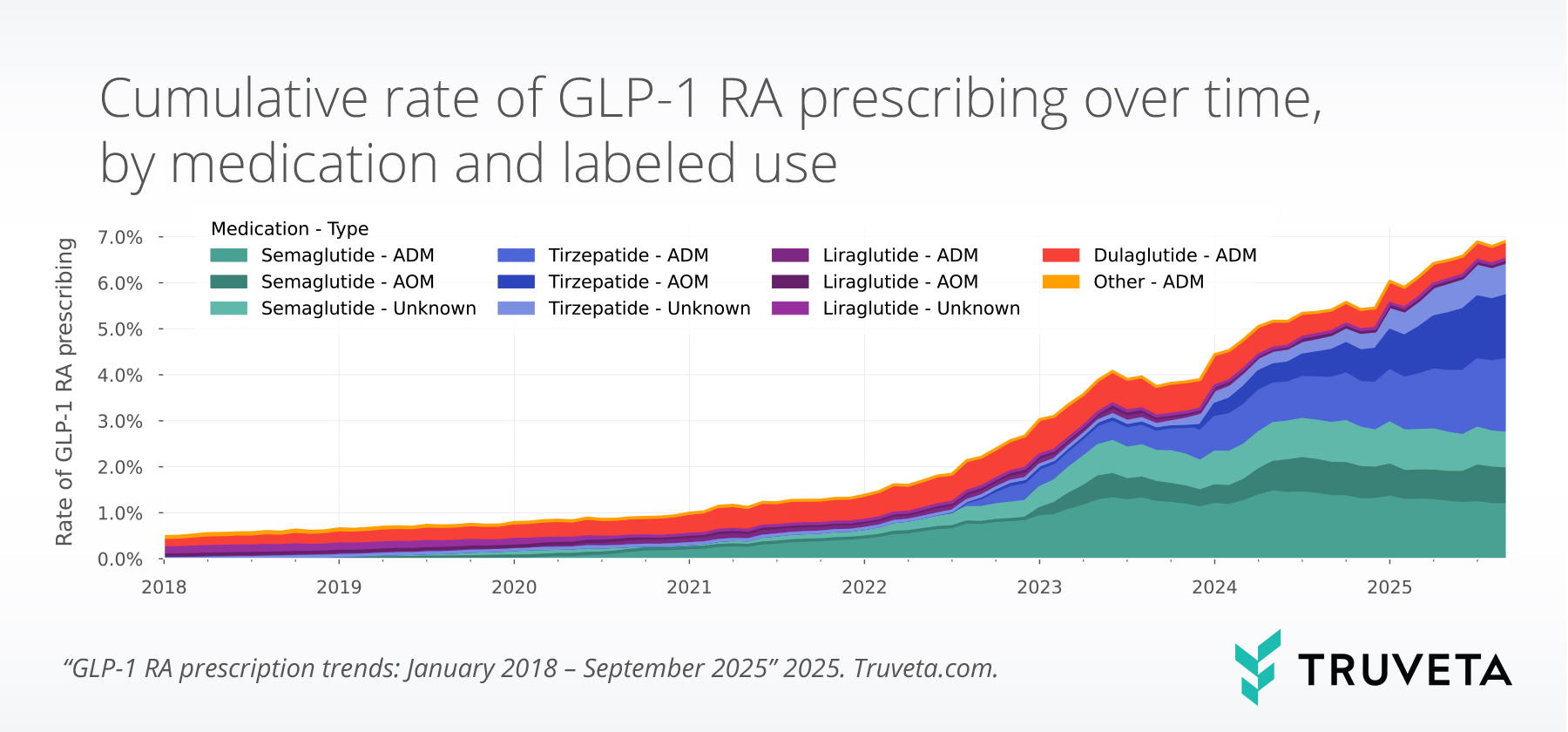
Month-over-month ADM prescribing continued to increase with time. ADM prescribing in September 2025 increased slightly compared to June 2025 (+5.2%).
Among ADMs, tirzepatide continues to be the most prescribed ADM medication.
AOM prescribing also increased each month between June and September 2025, with an overall increase of +6.7%. Among AOMs, tirzepatide is the most prescribed AOM medication. AOM tirzepatide had small fluctuations between June and August 2025, before increasing in September 2025. AOM semaglutide increased from June to July (potentially impacted by the CVS GLP-1 formulary change) but remained relatively stable through September.
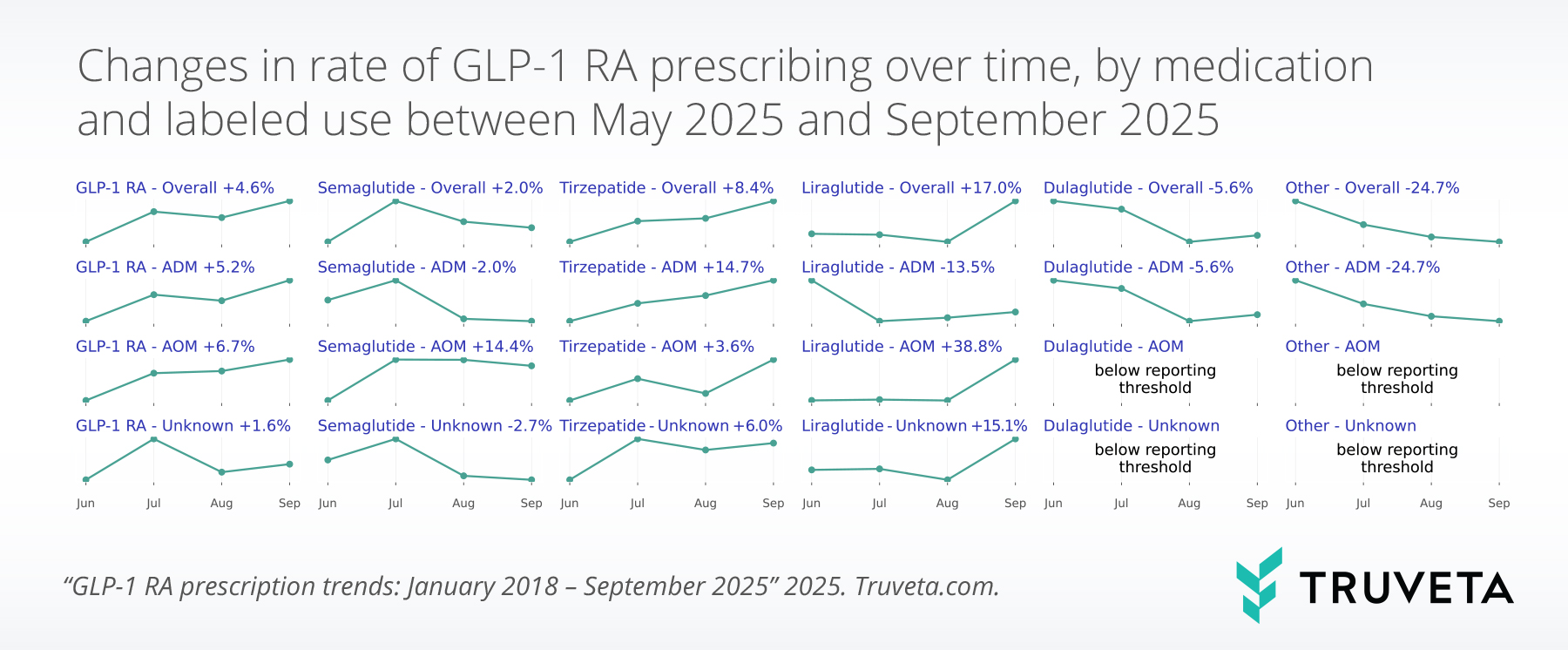
Trends in first-time prescribing
First-time prescribing rates (first-time GLP-1 RA prescriptions per total prescriptions) in September 2025 are slightly decreased compared to June 2025 (-12.5%).
First-time prescribing of ADMs decreased in September 2025, relative to June 2025 (-16.8%).
First-time prescribing of AOMs also decreased in September 2025, relative to June 2025 (-9.5%).
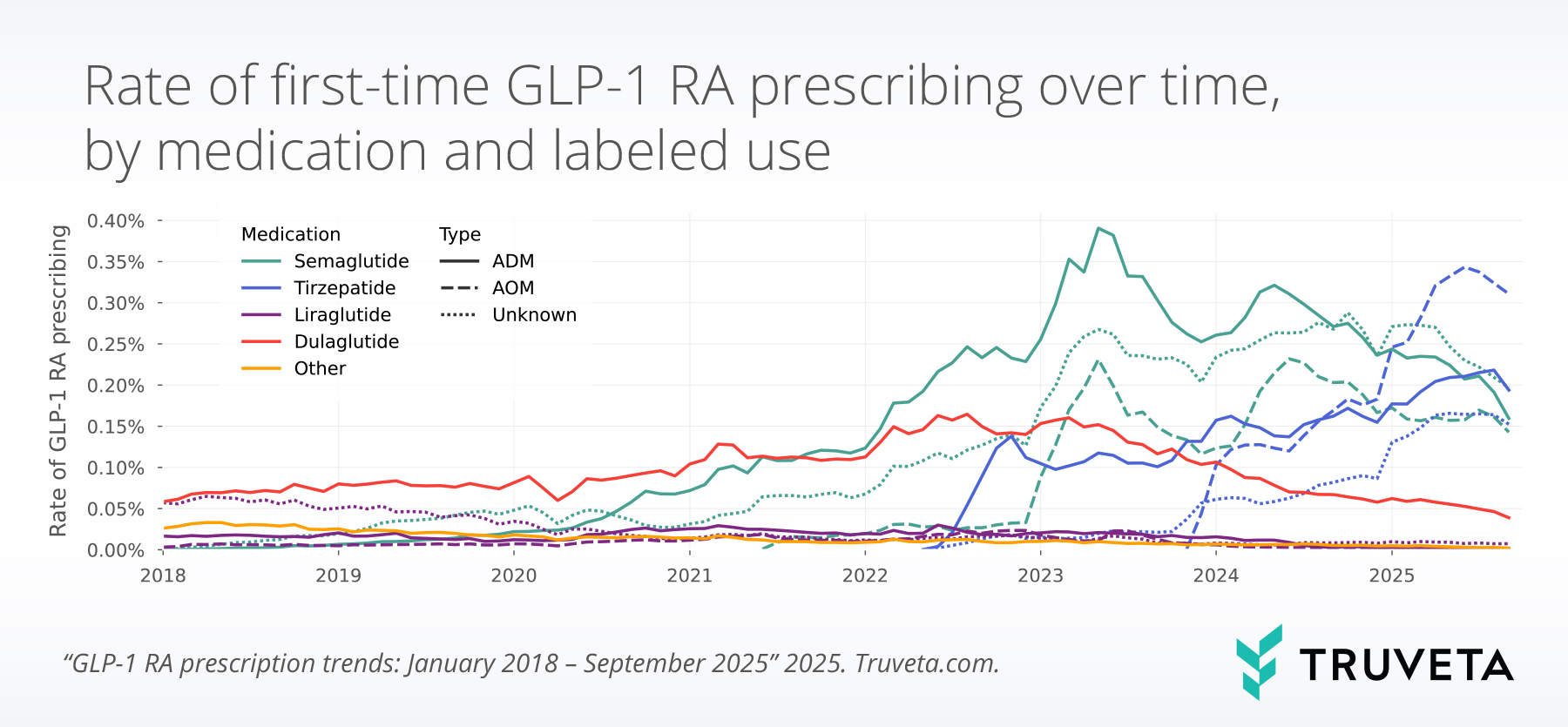
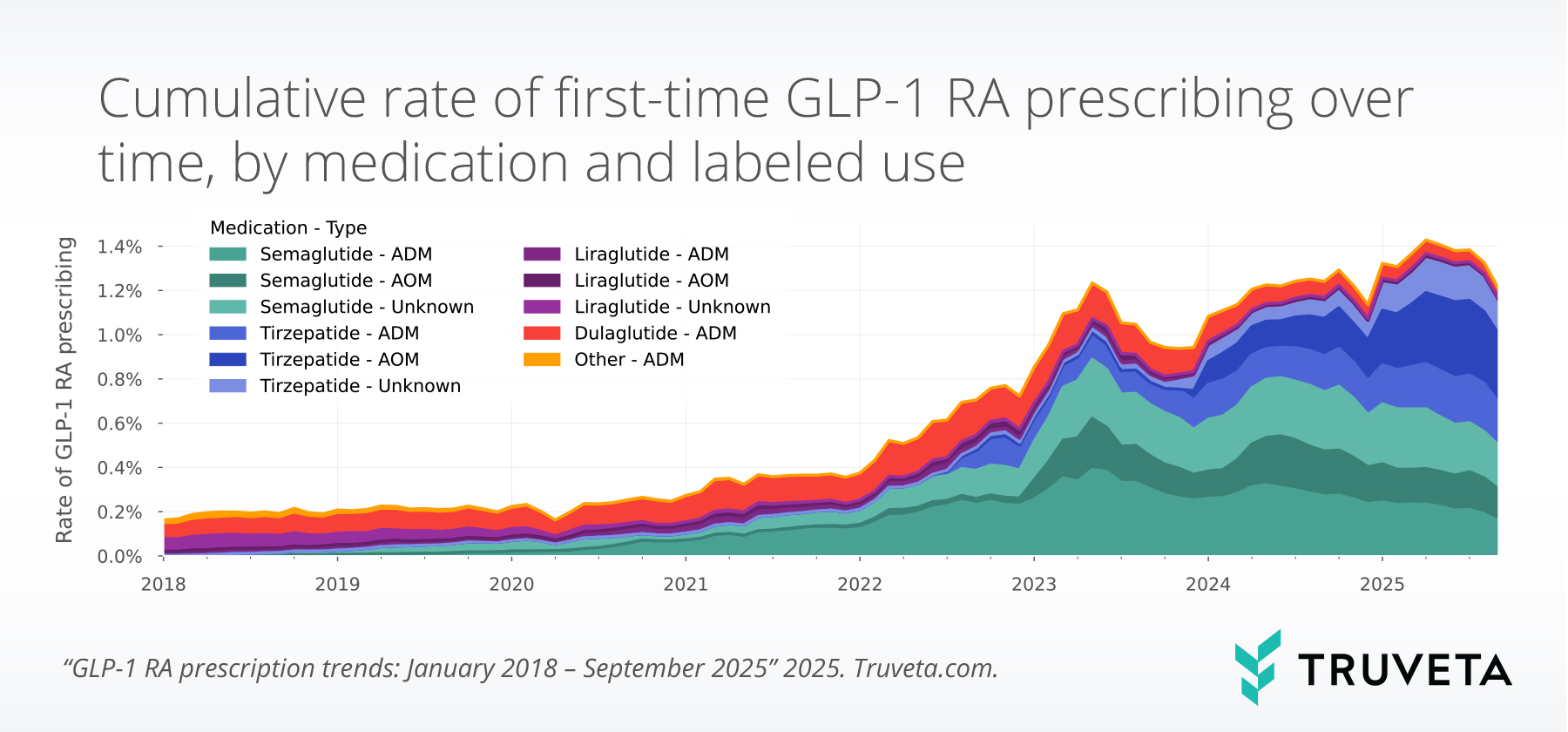
First-time prescribing of both ADM (-23%) and AOM (-9.4%) semaglutide decreased throughout the quarter.
First-time prescribing of ADM tirzepatide also decreased (-7.9%), as did first-time prescribing of AOM tirzepatide (-9.5%) as well.
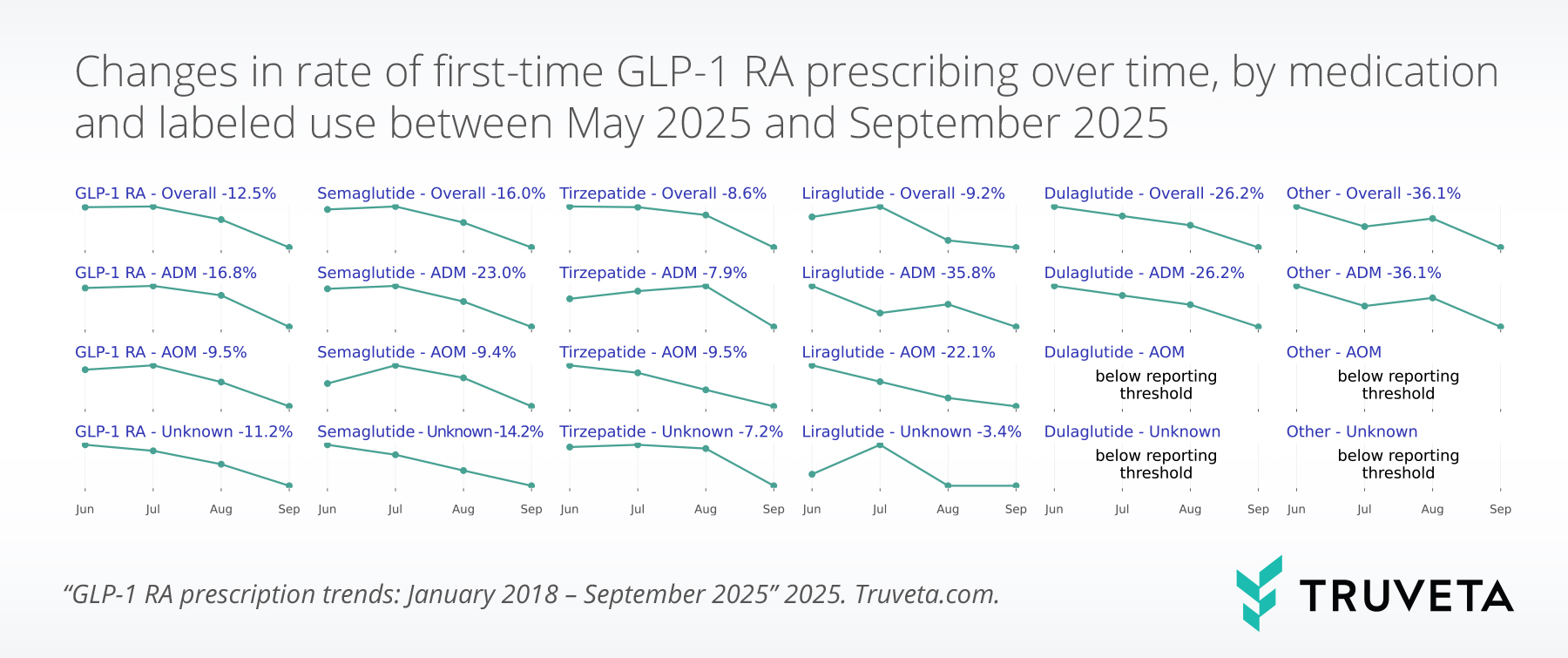
Dispense trends
Dispense refers to prescription fills, indicating that the patient picked up the medication from their pharmacy and provides the closest proxy for use.
During the full time period, 71.6% of GLP-1 RA prescriptions had a dispense within 60 days of their prescription (e.g., were initiated within 60 days).
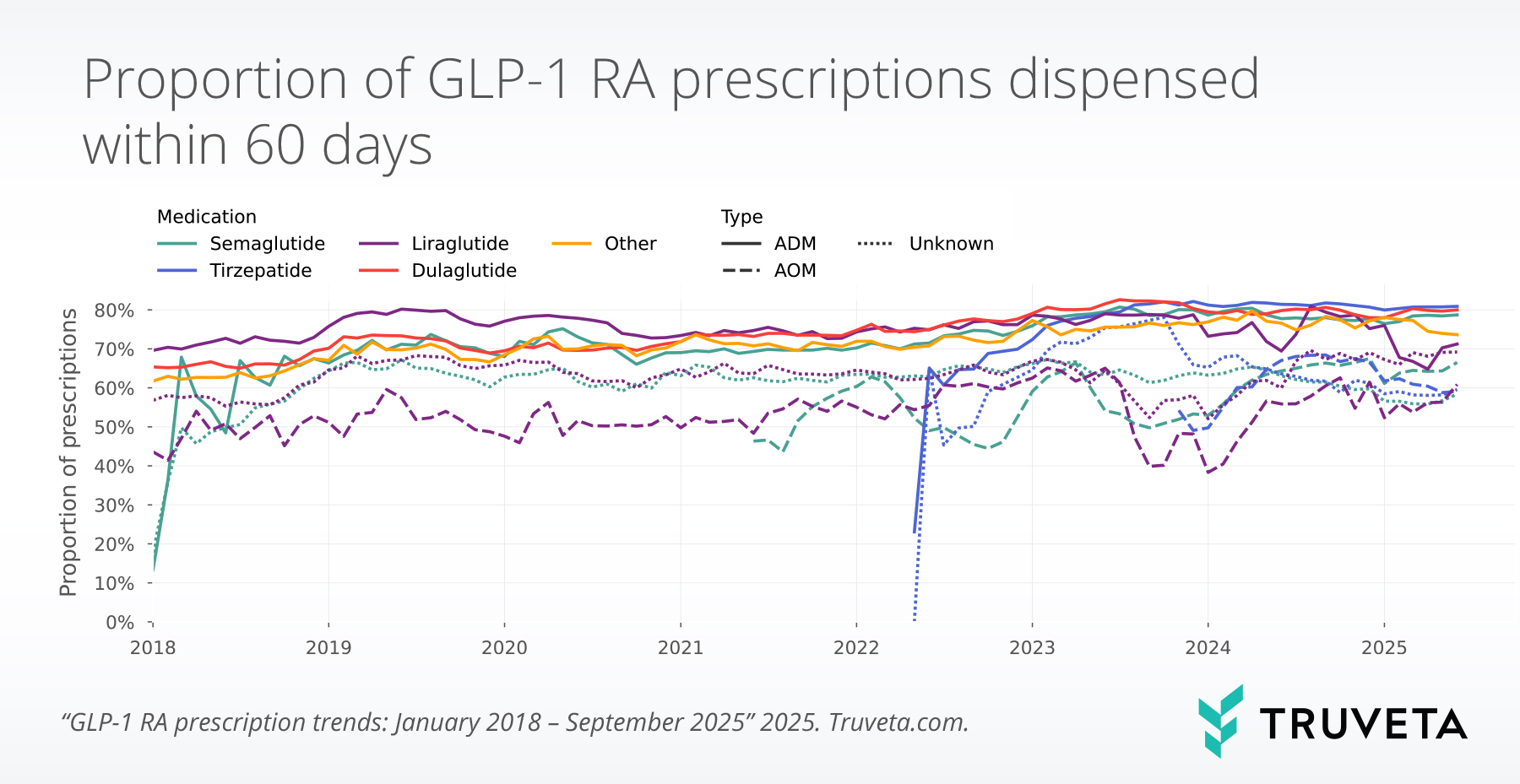
For patients first prescribed an ADM in June 2025, 72.2% filled a GLP-1 RA within 60 days. Initiation rates for ADM GLP-1 RA are about the same in June 2025, relative to March 2025 (+1.1%).
For patients first prescribed an AOM in June 2025, 46.8% filled a GLP-1 RA within 60 days. Initiation rates for AOM GLP-1 RA are about the same in June 2025, relative to March 2025 (-1.3%).
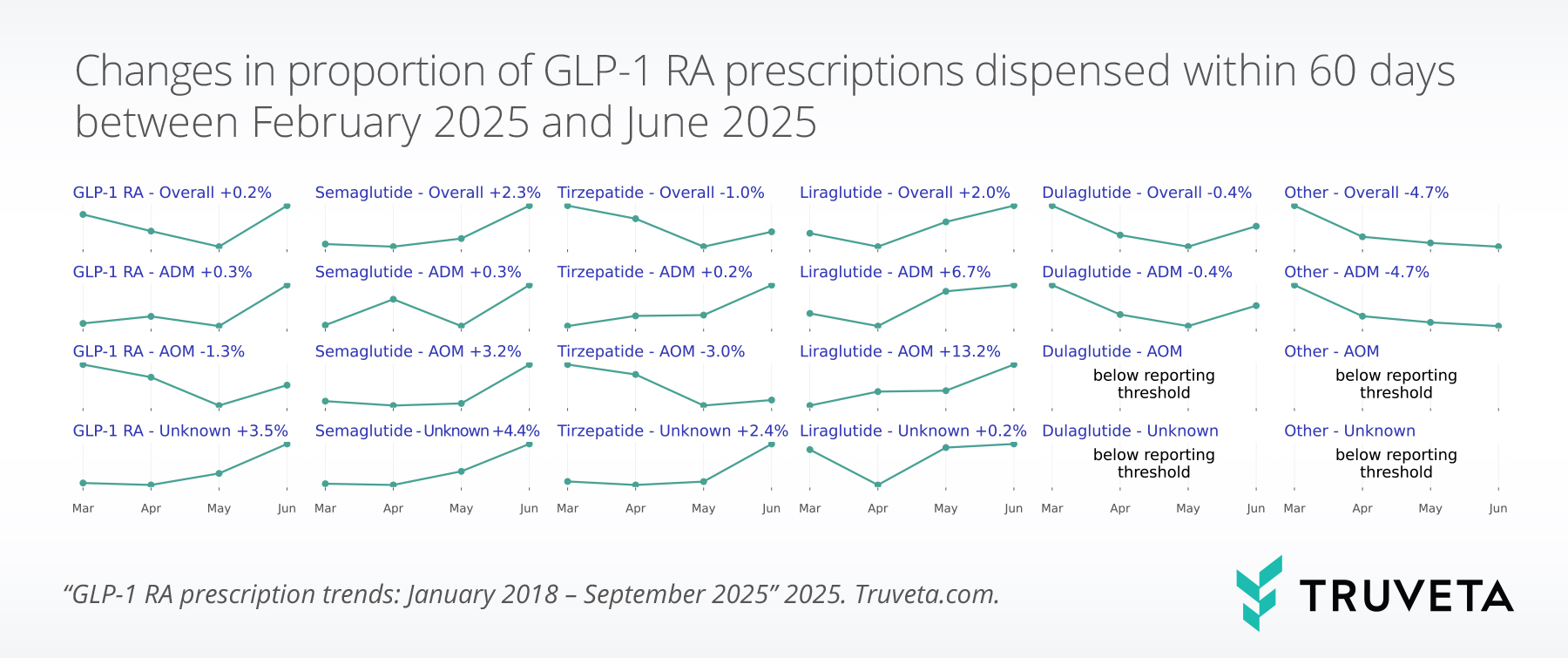
As a proxy for Medicare insurance, we segmented initiation rate by populations aged 65 and older versus those aged 18-64.
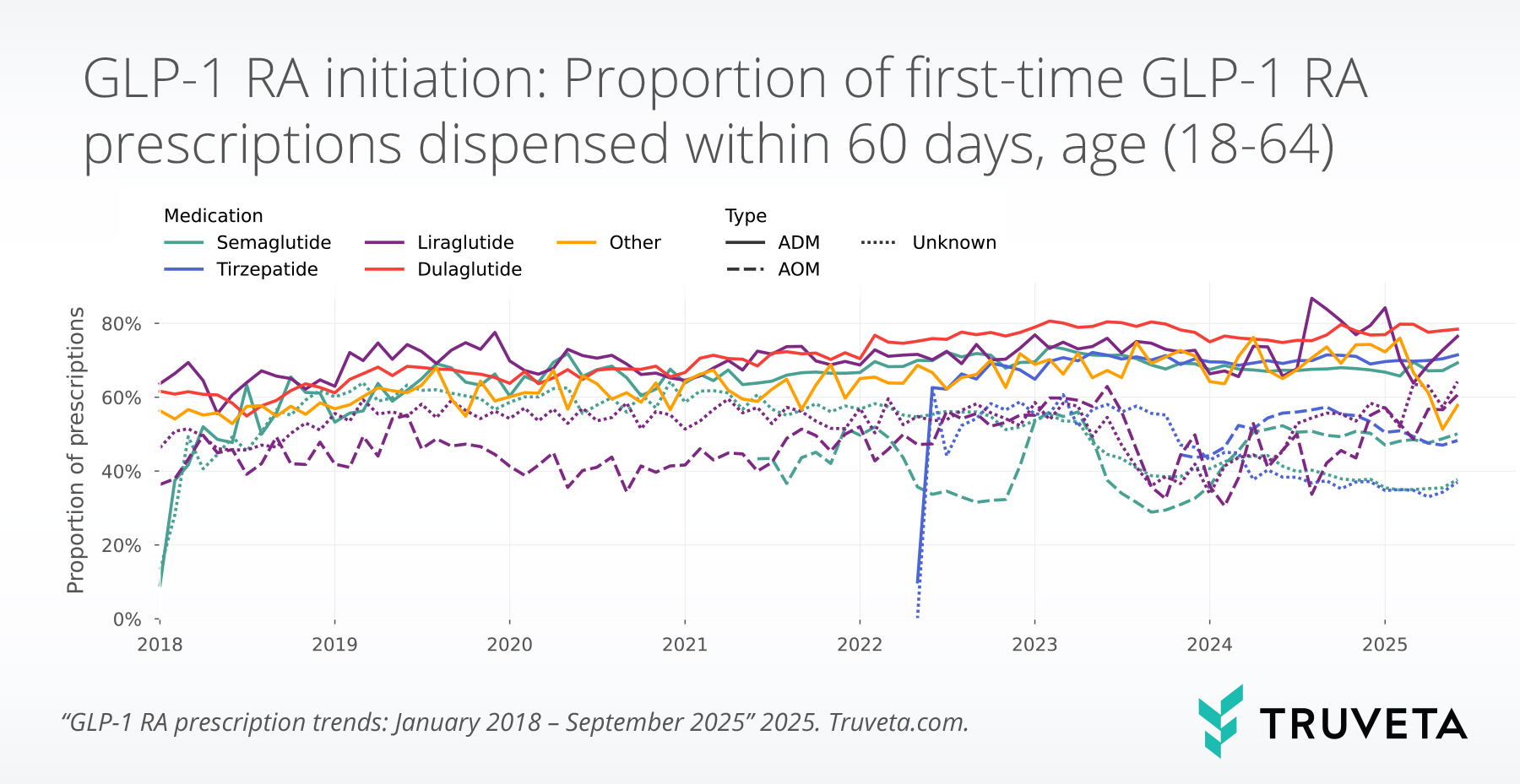
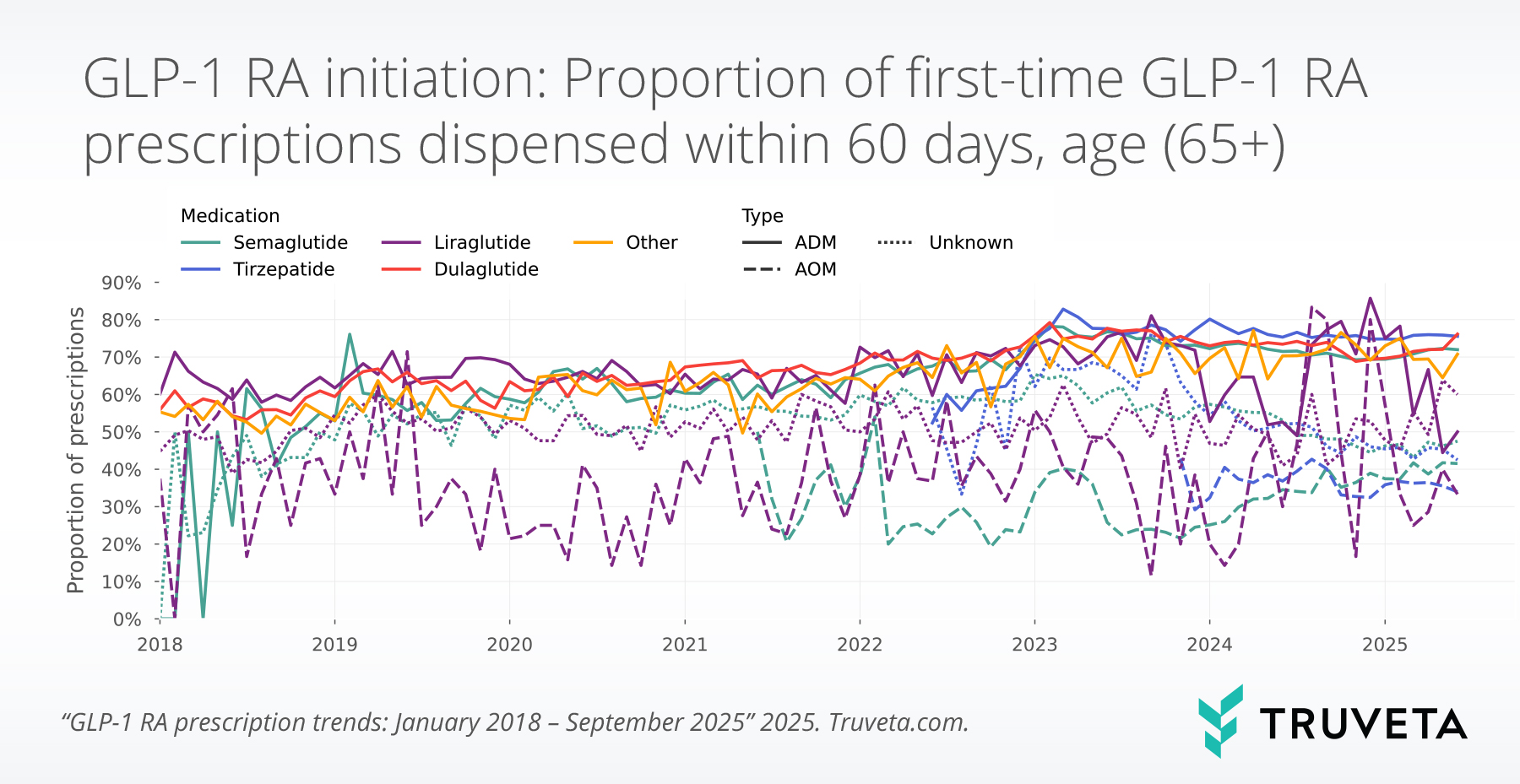
Discussion
With the popularity of GLP-1 RA medications and challenges in access and insurance coverage, we will continue to monitor these prescribing and dispensing trends over time.
The GLP-1 RA monitoring report describes more detailed information about the overall population of patients being prescribed these medications (including demographics and comorbidities), and the proportion and characteristics of patients who filled a GLP-1 RA prescription over time using dispenses. Methodologies, limitations, and citations are also available in the full report. You can also view the full study—including codes, definitions, and more—directly in Truveta Studio.
These are preliminary research findings and not peer reviewed. All data are preliminary and may change as additional data are obtained. These findings are consistent with data accessed October 10, 2025. Data presented in this analysis represent raw counts and/or rates, and post-stratification methods have not been conducted.

